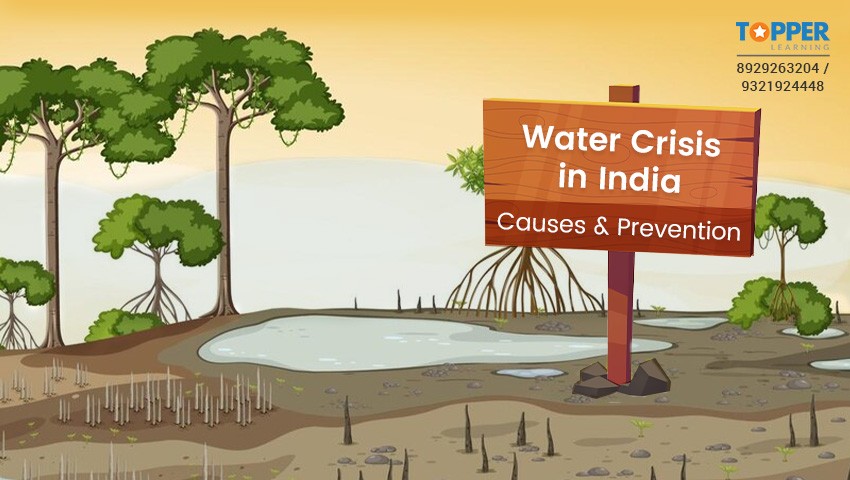Water Crisis in India: Causes and Prevention

Water is an essential element of life. Over the years, many countries, including India, have been facing major water crises. Learn about the most prevalent causes of the growing water scarcity and measures to prevent it.
By Topperlearning Expert 05th Apr, 2024 | 12:40 pm
ShareWater covers around 70% of the earth's surface, leading people to believe that it is plentiful. However, the freshwater we consume and use every day only accounts for 3% of the total amount of water on Earth, with two-thirds of that being glaciers or otherwise unavailable for use.
The future of India is significantly affected by the competing needs for this finite resource arising from homes, industry, and agricultural activities. The country proceeds to experience significant shifts brought on by its growing population and economy. Physical water scarcity results from a lack of water, which can present a variety of challenges and alternatives. Water scarcity can result from high demand, which is often brought about by poor infrastructure.
Cause of Water Crisis in Major Cities of India
Multiple factors cause the scarcity of water in India. The problem gets severe due to climate change, which results in erratic rainfall patterns and impacts river and groundwater recharge. A lack of infrastructure and poor water management heightens the problem.
Drought
Drought is widespread in hot, arid regions of India. Since these are areas where there is insufficient rainfall, the continued existence of inhabitants is affected. While some regions in India are always dry, others go through dry periods from time to time.
Population Growth
As the population rises, so does the demand for water, and rapid growth boosts economic growth, agricultural needs, and pollution. The course of growth causes loss of biodiversity and harm to water bodies. With more people increasing the demand for freshwater resources, water consumption keeps rising to excessive levels.
Global Warming
Water shortage is mostly caused by global warming, a phenomenon that raises average air temperatures, accelerates the evaporation of water from lake and river systems and may cause water bodies to dry up.
Water Pollution
Another element that contributes to water scarcity is unsafe and contaminated water. Several factors can contaminate water, such as sewage and wastewater, discharge from industry and agriculture, and pesticides and other toxic chemicals that seep into the groundwater system and surrounding freshwater systems. As a result, there is a shortage of fresh water and drinking water.
Ground Water and Improper Consumption of Water
In India, the levels of groundwater exploitation have risen at an alarming rate. Growing urbanisation has led to a surge in demand and widespread exploitation of groundwater and surface water resources. Once known for its many lakes, Bengaluru has turned into a concrete space where people consistently lack water. The lack of water has left a major impact on day-to-day living. Many people are unable to cook or clean effectively due to this scarcity of water. There is a decline in sanitation. Eventually, this will lead to increased disease risks.
What Can We Do to Prevent Water Crisis Conditions?
As responsible citizens of our country, we need to play significant roles to help with this scarcity of consumable water. The government of India is taking multiple steps to improve efficient water management and prevent water wastage.
Government Initiatives for Water Management in India
Here are some of the Government initiatives to prevent water scarcity in India:
- The Government of India, in collaboration with the State, is undertaking the Jal Jeevan Mission (JJM) to ensure tap water supply to all rural households in the country by 2024.
- The Mission Amrit Sarovar officially opened on National Panchayati Raj Day, April 24, 2022, which was part of the Azadi ka Amrit Mahotsav celebrations, with the goal of conserving water for future generations. The mission is to restore and develop seventy-five water bodies across all of the nation's districts.
- The Union Government started the Namami Gange Program, an Integral Conservation Mission, to achieve the dual goals of effectively reducing pollution and conserving and revitalising the National River Ganga.
- At the local level, Public Interaction Programs (PIP) are being organised to help consumers by sharing the findings of the National Aquifer Mapping and Management (NAQUIM) Studies.
Water Conservation Steps by People
Here are some steps people can take to overcome the scarcity of water.
- There are plenty of ways that we can conserve water, such as by using washing machines, rainwater harvesting, and taking brief showers
- Since soil has a greater capacity to absorb and hold water, an increase in green cover can help in the regeneration of groundwater.
- Rainwater collection and wastewater recycling can also tackle scarcity and reduce pressure on groundwater sources and other natural water sources.
- Another approach to prevent the water crisis from getting worse is to upgrade the drainage systems in particular areas.
- Encourage the implementation of water-efficient and sustainable technology for energy generation and power plant operation.
Conclusion
Water is an indispensable element of life. We need water for essential needs, from daily needs to agricultural needs and large industries. Water scarcity is not only a major issue in the world but has also immensely affected India. The growing population and economic growth have led to increased demand for water. We need to understand the need for water and try to waste water in every way possible to save water for future generations.
Save Water, Save Lives!
Stay connected to TopperLearning for more such informative reads. Follow us on WhatsApp Channels and get updated on the latest happenings!
FAQ's
Q 1. What are the benefits of sustainability?
Ans: Sustainability promotes the welfare of people and their surroundings. Sustainability encourages a more efficient economy with less waste and pollution, lower emissions, increased employment, and a more equitable distribution of income.
Q 2. What are green skills?
Ans: Technical expertise, proficiency, and aptitude that facilitate the efficient application of environmentally friendly processes and innovations in work environments are referred to as green skills. They use a variety of skills, principles, and perspectives to help people make environmentally responsible decisions at their jobs as well as in their daily lives.
Q 3. What are the components of a green economy?
Ans: In a green economy, both private and public investment in economic operations, infrastructures and resources that reduce greenhouse gas emissions and pollution, improve the use of energy and resources, and prevent ecosystem and biodiversity service loss drives job and income growth.
More from Education
Important Resources
- Education Franchisee opportunity
- NCERT Solution
- CBSE Class 9 Mathematics
- NCERT Solutions for class 10 Science
- Sample Papers
- CBSE Class 9 Science
- NCERT Solutions for class 10 Maths
- Revision Notes
- CBSE Class 10 Hindi
- CBSE Class 10 English
- CBSE Class 10 English
- CBSE Class 10 Social Studies
- CBSE Class 10 Science
- CBSE Class 10 Mathematics
- Career In Science After 10
- Career In Commerce After 10
- Career In Humanities/Arts After 10
- NCERT Solutions for Class 10
- NCERT Solutions for Class 11
- Business Studies Class 12 CBSE project





